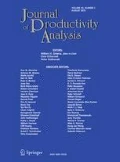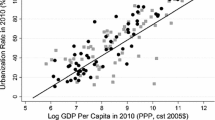Abstract
This paper examines the relation between the business cycle and convergence in levels of agricultural productivity across the 48 contiguous states. First, we find evidence of convergence in total factor productivity levels across the different phases of the business cycle, but the speed of convergence was greater during periods of contraction in economic activity than during periods of expansion. Second, we find that technology embodied in capital was an important source of productivity growth in agriculture. As with the rate of catch-up, the embodiment effect was much stronger during low economic activity phases of the business cycle.

Similar content being viewed by others
Notes
Ball et al. (2001), in a study of agriculture in twelve OECD countries, found evidence of convergence in levels of productivity. Moreover, the dispersion of their relative levels (as measured by the coefficient of variation) decreased over time.
Their tests for convergence are conditional on these variables. In the growth literature, this is referred to as conditional convergence. However, for simplicity of exposition we use the term convergence.
Dumagan and Ball (2009) provide a decomposition of changes in revenue into its components. This decomposition reveals that productivity growth in agriculture accounted for nearly two-thirds of the growth in revenue over the postwar period. The authors conclude that policy should focus more on measures to foster productivity growth (e.g., public funding of research) than often adopted price support programs to enhance growth in income.
Overshooting of prices refers to temporary changes beyond long-run equilibrium levels.
A particular case in which this can happen is when we only consider export markets where we observe zero trade flows between specific pairs of countries (see Helpman et al. 2008).
If most exiting farms were concentrated in states with lower initial aggregate productivity the bias would be negative (i.e., biased towards β-convergence). If most exiting farms were concentrated in the states with higher initial aggregate productivity, the bias would be positive (i.e., biased against β-convergence). Finally, if there were no statistically significant differences in the exit rates between the most productive states and the less productive states the results would be unbiased.
Ball et al. (2004) also allowed for embodiment of technology in materials inputs, but the estimated effect was not statistically significant. They attributed this result to adjusting the input indexes for quality change.
The capital intensities are defined over machinery and equipment and non-residential structures.
We use the term ‘spillovers’ because our measures of educational attainment and worker experience pertain to the total workforce in each state as opposed to the agricultural workforce in that state.
In the most basic specification, only the initial and final periods are considered. We, on the other hand, construct growth rates for overlapping periods. The advantage of using overlapping periods is that the estimates are less sensitive to starting and ending dates.
The production accounts are available electronically at: http://www.ers.usda.gov/data-products/agricultural-productivity-in-the-us.aspx.
It is likely that at least some technological innovation is embodied in materials inputs such as fertilizers and pesticides. However, the input quantities are measured implicitly using hedonic price indexes; they are adjusted for changes in input quality. The resulting input measures will be uncorrelated with changes in productivity (see Jorgenson and Griliches 1967; Ball et al. 2004).
Baier et al. (2007) use a perpetual inventory method to construct average years of schooling and experience of the work force for each state. The data span the years 1840–2000. Estimates for the years 2001–2004 were extrapolated using TRAMO. TRAMO is a program for MLE of regression models with general non-stationary errors, outliers, and long sequences of missing observations (see Gómez and Maravall 1997; Maravall 2005).
A complete description of methods and data used to construct the market accessibility and domestic and external demand variables is provided in an appendix available from the authors.
References
Abramovitz M (1986) Catching up, forging ahead, and falling behind. J Econ Hist 46:385–406
Akerlof GA, Rose AK, Yellen JL (1998) Job switching and job satisfaction in the U.S. Labor Market. Brook Pap Econ Act 1998(2):495–582
Baier S, Mulholland S, Tamura R, Turner C (2007) Education and income of the States of the United States: 1840–2000. J Econ Growth 12(2):101–158
Baldwin J, Gorecki PA (1991) Entry, exit and productivity growth. In: Geroski PA, Schwalbach J (eds) Entry and market contestability: an international comparison. Blackwell, Oxford
Ball VE, Gollop F, Kelly-Wawke A, Swinand G (1999) Patterns of state productivity growth in the U.S. Farm Sector: linking state and aggregate models. Am J Agric Econ 81(1):164–179
Ball VE, Bureau J-C, Butault J-P, Nehring R (2001) Levels of farm sector productivity: an international comparison. J Prod Anal 15:5–29
Ball VE, Hallahan C, Nehring R (2004) Convergence of productivity: an analysis of the catch-up hypothesis within a panel of states. Am J Agric Econ 86(5):1315–1321
Baltagi B (2005) Econometric analysis of panel data, 3rd edn. Wiley, West Sussex
Baltagi B, Li Q (1995) Testing AR(1) against MA(1) disturbances in an error component model. J Econom 68:133–151
Barro R, Sala-i-Martin X (1992) Convergence. J Polit Econ 100(2):223–251
Basu S, Fernald JG (2001) Why is productivity procyclical? Why do we care? In: Hulten C, Dean E, Harper M (eds) New developments in productivity analysis. The University of Chicago Press, Chicago, pp 225–302
Baumol W (1986) Productivity growth, and welfare: what the long run data show. Am Econ Rev 76(5):1072–1085
Baumol W, Wolff E (1988) Productivity growth, convergence, and welfare: reply. Am Econ Rev 78(5):1155–1159
Breitung J (2000) The local power of some unit root tests for panel data. Adv Econom 15:161–177
Breusch T, Pagan A (1980) The Lagrange multiplier test and its applications to model specification in econometrics. Rev Econ Stud 47:239–253
Cungun A, Swinnen JFM (2003) Transition and total factor productivity in agriculture 1992–1999. Working paper, Research Group on Food Policy, Transition & Development (PRG-Leuven), Katholieke Universiteit Leuven, 2003/2
Daveri F, Jona-Lasinio C (2007) Off-shoring and productivity growth in the italian manufacturing industries. Working Paper 53, Luiss Lab of European Economics (LLEE)
Davidson R, MacKinnon R (1993) Estimation and inference in econometrics. Oxford University Press, Oxford
Di Liberto A, Mura R, Pigliaru F (2008) How to measure the unobservable: a panel technique for the analysis of TFP convergence. Oxf Econ Pap 60(2):343–368
Dollar D, Wolff EN (1994) Capital intensity and TFP convergence by industry in manufacturing. In: Baumol W, Nelson R, Wolff E (eds) Convergence of productivity: cross-national studies and historical evidence. Oxford University Press, New York, pp 197–224
Dowrick S, Nguyen D (1989) OECD comparative economic growth 1950–85: catch-up and convergence. Am Econ Rev 79(5):1010–1030
Dumagan J, Ball VE (2009) Decomposing growth in revenue and cost into price, quantity, and multifactor productivity contributions. Appl Econ 41:2943–2953
Eisfeld AL, Rampini AA (2006) Capital reallocation and liquidity. J Monet Econ 53:369–399
Escribano A, Stucchi R (2008) Catching up in total factor productivity through the business cycle: evidence from Spanish manufacturing surveys. Working Paper 08-51, Universidad Carlos III de Madrid
Evenson RE, Huffman WE (2001) Structural and productivity change in US Agriculture, 1950–1982. Agric Econ 24:127–147
Foote CL (1998) Trend employment growth and the bunching of job creation and destruction. Q J Econ 113:809–834
Foster L, Haltiwanger J, Krizan CJ (1998) Aggregate productivity growth: lessons from microeconomic evidence. Working Paper, NBER, 6803
Fujita S (2008) Creative destruction and aggregate productivity growth. Bus Rev (Federal Reserve Bank of Philadelphia) 2008(3):12–20
Geroski P, Walters CF (1995) Innovate activity over the business cycle. Econ J 105(431):916–928
Gómez V, Maravall A (1997) Programs TRAMO and SEATS: instructions for the user (Beta Version: June 1997). Working Paper 97001, Ministerio de Economia y Hacienda Espana
Gopinath M, Upadhyay MP (2002) Human capital, technology, and specialization: a comparison of developed and developing countries. J Econ 75(2):161–179
Groth C, Nuñez S, Srinivasan S (2006) Productivity growth, adjustment costs and variable factor utilization: the UK case. Working Paper 295, Bank of England
Hansen LP (1982) Large sample properties of generalized methods of moments estimators. Econometrica 50(4):1029–1054
Harris CD (1954) The market as a factor in the localization of industry in the United States. Ann Assoc Am Geogr 44:315–348
Hart OD (1985a) Monopolistic competition in the spirit of Chamberlin: a general model. Rev Econ Stud 52:529–546
Hart OD (1985b) Monopolistic competition in the spirit of Chamberlin: special results. Econ J 95:1251–1271
Hausman JA (1978) Specification tests in econometrics. Econometrica 46(6):1251–1271
Helpman E, Melitz M, Rubinstein Y (2008) Estimating trade flows: trading partners and trading volumes. Q J Econ 123(2):441–487
Im KS, Pesaran MH, Shin Y (2003) Testing for unit roots in heterogeneous panels. J Econom 115:53–74
Jorgenson D, Griliches Z (1967) The explanation of productivity change. Rev Econ Stud 34:249–283
Jovanovic B, MacDonald G (1994) Competitive diffusion. J Polit Econ 102(1):24–52
Kleibergen F, Paap R (2006) Generalized reduced rank tests using the singular value decomposition. J Econom 133:97–126
Levin A, Lin CF, Chu C (2002) Unit root test in panel data: asymptotic and finite sample properties. J Econom 108:1–25
Levinson J, Petrin A (2003) Estimating production functions using inputs to control for unobservables. Rev Econ Stud 70(2):317–341
Maravall A (2005) An application of TRAMO SEATS automatic procedure; direct vs indirect adjustment. Working Paper 0524, Banco de Espana
Martin W, Mitra D (1999) Productivity growth and convergence in agricultural and manufacturing. Policy Research Working Paper 2171, World Bank
McCunn A, Huffman WE (2000) Convergence in U.S. productivity growth for agriculture: implications of interstate research spillovers for funding agricultural research. Am J Agric Econ 82:370–388
Parman JM (2009) Good schools make good neighbors: human capital spillovers in early 20th century agriculture. Working Paper (June 15). Available at SSRN: http://www.econ.ucdavis.edu/faculty/jparman/
Phillips PCB, Perron P (1988) Testing for unit roots in time series regression. Biometrika 75:335–346
Quah D (1993a) Empirical cross-section dynamics in economic growth. Eur Econ Rev 37(2/3):427–443
Quah D (1993b) Galton’s fallacy and test of convergence analysis. Scand J Econ 95(4):427–443
Rucker R, Sumner D (1997) Agriculture and business cycles. In: Glasner D (ed) Business cycles and depressions: an encyclopedia. Garland publication, New York, pp 10–12
Sargan JD (1958) The estimation of economic relationships using instrumental variables. Econometrica 26:393–415
Theil H (1954) Linear aggregation of economic relations. Amsterdam, North Holland
Wolff E (1991) Capital formation and productivity convergence over the long term. Am Econ Rev 81(3):565–579
Wooldridge J (2002) Econometric analysis of cross section and panel data. MIT Press, Cambridge
Author information
Authors and Affiliations
Corresponding author
Additional information
The views expressed in this article are those of the authors and should not be attributed to the Economic Research Service or the US Department of Agriculture.
Rights and permissions
About this article
Cite this article
Ball, V.E., San-Juan-Mesonada, C. & Ulloa, C.A. State productivity growth in agriculture: catching-up and the business cycle. J Prod Anal 42, 327–338 (2014). https://doi.org/10.1007/s11123-013-0352-0
Published:
Issue Date:
DOI: https://doi.org/10.1007/s11123-013-0352-0




